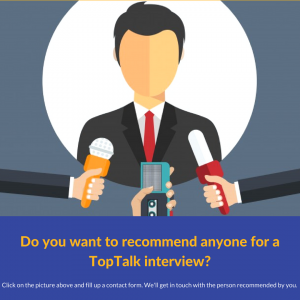 Gabor George Burt is one of the core, original experts of Blue Ocean Strategy, the new millennium’s most influential management concept, and contributor to the worldwide bestselling BOS book. He launched the Slingshot Framework in 2011 – as an expansion of his BOS work. Slingshot enjoys worldwide recognition and is at the forefront of global innovation. The framework shows how to engage creative thinking to systematically re-imagine market boundaries, filling a major global need: An IBM survey of 1,500 CEOs worldwide found that ‘creativity’ is considered the single most important leadership trait for future
Gabor George Burt is one of the core, original experts of Blue Ocean Strategy, the new millennium’s most influential management concept, and contributor to the worldwide bestselling BOS book. He launched the Slingshot Framework in 2011 – as an expansion of his BOS work. Slingshot enjoys worldwide recognition and is at the forefront of global innovation. The framework shows how to engage creative thinking to systematically re-imagine market boundaries, filling a major global need: An IBM survey of 1,500 CEOs worldwide found that ‘creativity’ is considered the single most important leadership trait for future
success.
Gabor is recognized among top 13 innovation visionaries: https://www.cio.com/article/3203028/leadership-management/13-disruption-quotes-to-kickstart-your-innovation.html
Among high-profile events, delivered an opening presentation at Global Marketing Forum, designed and hosted the Forum for Partnership of the Americas, a gathering of business and government leaders from across the
Western Hemisphere. Shared stage with Seth Godin and Sir Richard Branson at Forum One.
In 2016, was one of three judges for the E.U. Innovation Venture Award, since 2017 sits on the Board of the Global Innovation Institute, and both designed and
keynoted the Arab Innovation Forum in Dubai in 2018, to be replicated worldwide.
Leads immersive gatherings of VIP participants, and is launching The Slingshot Awards to recognize organizations, individuals, and initiatives that are re-imagining boundaries with the most impact. See www.gaborgeorgeburt.com for more details of his activities.
Published articles in the Harvard Business Review: hbr.org/2016/08/keeping-customers-continuously-infatuated, hbr.org/2016/04/what-we-can-learn-from-one-of-the-worlds-most-mocked-cars
What does organizational culture mean to you?
Organizational culture is the inner fabric of shared values, objectives, and relationship processes of a company group.
What are the major determinants of organizational culture?
Major determinants include the organization’s leadership, operating environment and key societal influences.
What is the role of employees in organizational culture?
Employees make wide-ranging contributions to the success of each organization. More than specific skills and expertise, each employee has significant creative abilities. The role, impact, and fulfillment of employees is what organizational culture should aim to optimize. And in turn, employees absorb and bring to life that culture in the way they work and interact.
What are the common problems associated with managing organizational culture?
Traditional organizational culture in business focused on hierarchy, clear definitions of tasks and order. Such a culture tried to maximize the efficiency of employees as a factor of production, exemplified by the concepts of scientific management. Such a culture repressed rather than nurtured the creative contribution of employees. With the profound shift to an environment of continuous, unpredictable and accelerating change over the past couple of decades, there is now widespread recognition of the importance and scarcity of creative thinking within organizations. In this new setting, creativity is regarded as one of the most essential, yet vastly underutilized resources
Re-Imagine Your Business, Re-Imagine Your Life driving the ongoing success and sustained relevance of organizations. The big question is how can creativity be jumpstarted and sustained in cultures that previously failed to harness its power?
What are the ways to innovate company culture? Any best practices to share.
The good news is that applying our creative abilities is our natural state, evidenced by the deep way we all used our imagination as children. Dr. Seuss, the iconic, American writer and illustrator of cross-generational children books, once famously said: “Adults are just obsolete children”. Creativity therefore not only enables organizations to excel when it is collectively applied but also allows us to maximize our personal fulfillment on an individual level. When our creative input is valued we feel more engaged, and we perform at our full potential. What organizations need to do is to craft an environment that reconnects its employees with their natural state of imaginative thinking and keeps them connected.
One of the most universal manifestations of creativity is humor. Not surprisingly, more and more organizations worldwide are embracing humor as a core cultural
dimension, encouraging amusing messaging, activities, and interactions within senior executives as well as general staff. High profile examples of business trailblazers with humorous, playful leadership styles include Richard Branson and Jack Ma. We also see an exponential, global proliferation from year to year of companies commemorating April Fools’ Day, the annual celebration of laughter and childlike fun. These organizations conceive of and bring to life farcical campaigns on April 1st, (e.g. Google announcing Google Nose a few years ago, to enable us to conduct online searches by smell), signaling to all internal and external constituents that they, as an organization, have a sense of humor and appreciate levity.
So if you want to maximize your organization’s future success, cultivate a culture with a sense of humor. You can start by creating your own corporate April Fools’ Day campaign.
